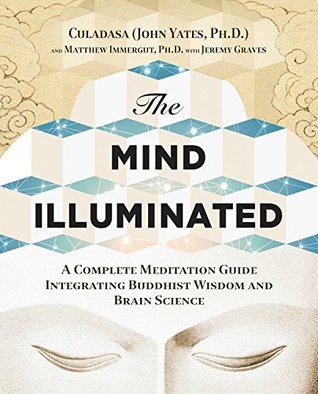More on this book
Community
Kindle Notes & Highlights
Read between
December 11, 2015 - April 16, 2017
sensations produced by breathing,
Although the breath as meditation object has many benefits, the same principles and methods apply to any meditation object, and most other meditation techniques.
All the same principles can be employed in conjunction with the noting technique of the Mahasi-style vipassanā method, the breath concentration and body-scanning techniques of the U Ba Khin/Goenka vipassanā method, or the uniquely systematic vipassanā of Shinzen Young.
A Gradual Four-Step Transition to the Meditation Object
let it come, let it be, let it go
Cultivating stable attention will continue all the way through Stage Six.
Sit down, close your eyes, and go through the Six Point Preparation for Meditation: Motivation, Goals, Expectations, Diligence, Distractions, and Posture.
Then, do the Four-Step Transition, gradually restricting the natural movements of your attention as you move from one Step to the next. The transition needs to be gentle and gradual. Emphasize relaxation, peacefulness, and pleasure, rather than willpower and effort.
When you reach Step Four and you’re focusing on the breath at the nose, stabilize your attention by counting five or ten breaths without interruption. When you’re finished counting, keep at...
This highlight has been truncated due to consecutive passage length restrictions.
You’ll have to overcome four major obstacles: not enough time, procrastination, reluctance and resistance to practicing, and doubt.
The practical steps: choose a suitable time and place, find the posture that’s best for you, cultivate the right attitude, and generate strong motivation.
You will have to make adjustments in other parts of your life. If you don’t make meditation a higher priority than other things, it just won’t happen.
A regular place for meditation is as important as a regular time. It’s best to have a place just for meditating.
You can’t overcome all discomfort by adjusting your posture. Eliminate what you can, but accept what remains as part of your practice.
“A good meditation is one you did; the only bad meditation is one you didn’t do.”
Support and inspire others, and let them support and inspire you. As the Buddha once told Ananda, “Noble friends and companions are the whole of the holy life.”
The Hindrances and Problems
Frisbee,
Think of meditation as mental training that exercises certain “mental muscles” so they respond more easily and better serve your needs.
All the mental skills needed in meditation are innate abilities. Meditation trains certain “mental muscles.”
The Five Hindrances
Worldly Desire, Aversion, Laziness and Lethargy, Agitation due to Worry and Remorse, and Doubt.
Almost every problem in meditation can be traced to one or some combination of the Five Hindrances
five Meditation Factors1: Directed Attention, Sustained Attention, Meditative Joy, Pleasure/Happiness, and Unification of Mind.
Familiarize yourself with the hindrances and their antidotes. Recognizing them both in meditation and daily life will pay off quite well.
Worldly Desire
Worldly Desire (sometimes called Sense Desire) is when we pursue, delight in, and cling to the pleasures of material existence.
having pleasurable experiences and avoiding pain;
attaining the love and admiration of others while avoiding hatred and blame.
we’re social animals, so we take pleasure in and crave acceptance, status, and power, because they’re important to our survival and reproduction as well.
Meditation does not repress Worldly Desire. It frees you from being ruled by desire.
non-grasping and equanimity
new motivations will come from a place of generosity, loving-kindness, and shared joy.
We can act effectively from a foundation of reason and equanimity. Furthermore, generosity, loving-kindness, and sympathetic joy will only serve to enhance the survival of social beings like ourselves.
Aversion
Aversion (sometimes called ill-will) is a negative mental state involving resistance.
You will learn to replace Aversion with loving-kindness, compassion, and harmlessness.
You will learn to recognize Aversion, replacing it with equanimity, acceptance, and patience.
Laziness and Lethargy Laziness mostly appears as procrastination. Its counterpart, lethargy, is a tendency toward inactivity, rest, and ultimately sleep. Both involve a lack of energy.
The second antidote is to just do it.
Directed attention becomes powerful and automatic enough to completely overcome Laziness and Lethargy.
The Meditation Factor of Directed Attention4 opposes Laziness and Lethargy, and vice versa.
Agitation Due to Worry and Remorse
Joy overcomes Worry by giving you confidence that you can handle life’s challenges. Joy overcomes Remorse by making you eager to set things right.
Doubt
Success leads to trust—both in the practice and yourself. By applying yourself diligently, Doubt is completely overcome.
The Seven Problems
Distractions, forgetting, and mind-wandering: The hindrances of Worldly Desire, Aversion, Agitation, and Doubt can all manifest as distractions that cause forgetting, then mind-wandering. Thoughts about the worldly dharmas—wealth, pleasure, fame, and praise—are far more engaging for a novice than the sensations of the breath.
Dullness, drowsiness, and falling asleep: The hindrance of Laziness and Lethargy create dullness and drowsiness, but it’s mostly due to the Lethargy. Lethargy is a decrease in mental energy that manifests as a comfortable, pleasant dullness of perception, or as heavy drowsiness. As mental activity dies down, mental energy falls, as do interest, awareness, and responsiveness.
In Conclusion


